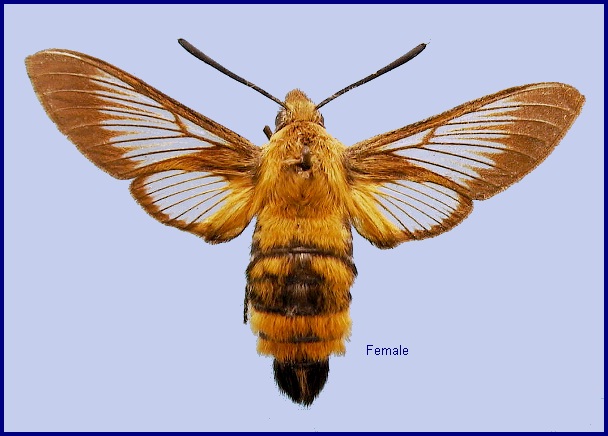
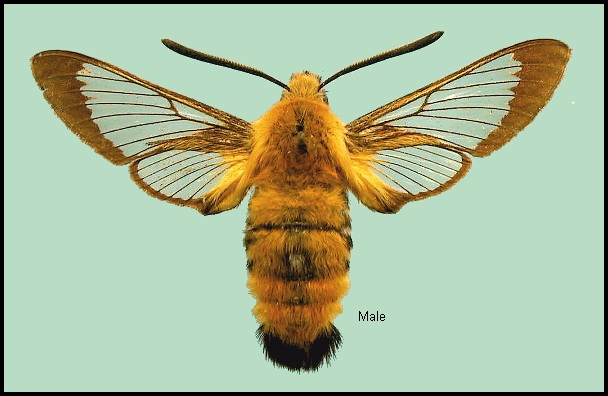
Sesia radians Walker, 1856, List Specimens lepid. Insects Colln Br. Mus. 8: 84. Type locality: North China, Shanghai.
Synonym. Sesia radians Walker, 1856.
Synonym. Hemaris mandarina Butler, 1875.
Synonym. Macroglossa fuciformis brunneobasalis Staudinger, 1892.
[Further details on this species in Japan, as well as photos of many stages, can be found on Digital Moths of Japan.]
Wingspan: 37--40mm. Dorsal surface of thorax and abdomen naturally ochreous (with no trace of green), as are the base of the hindwings. Forewing discal cell longitudinally divided by a distinct or vestigial scale fold, rarely undivided; inner edge of marginal band unexpanded at M2, even (f. mandarina) or dentate (f. radians). Upperside of foretibia and foretarsus black; apical third of hindtibia blue-black like upperside of hindtarsus.
Male genitalia very similar to Hemaris tityus but gnathos more asymmetrical, obliquely rounded apically. Both valves slightly more spatulate. Female genitalia similar in general structure to Hemaris tityus, but antrum funnel-shaped, not square.
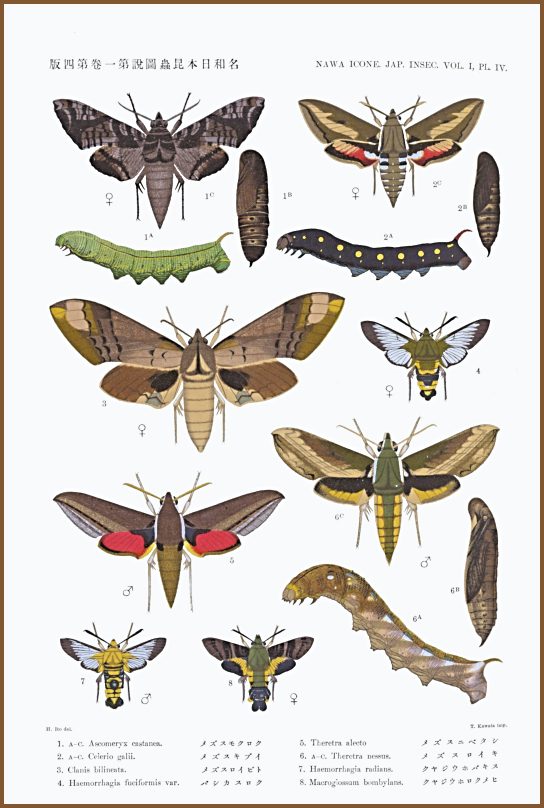
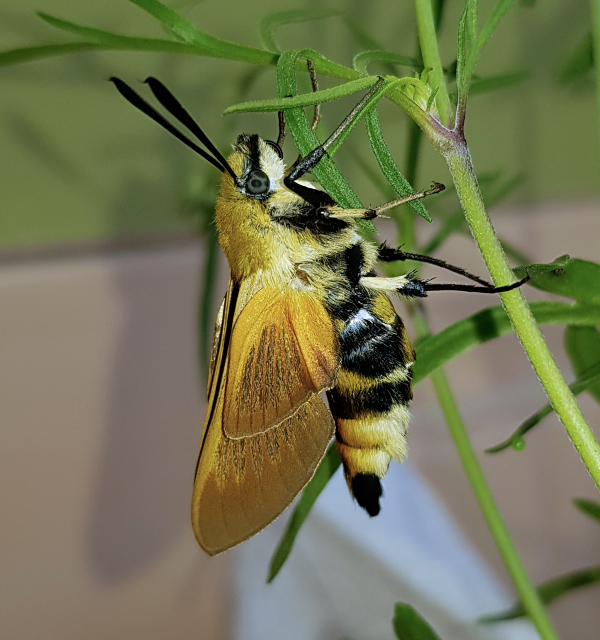
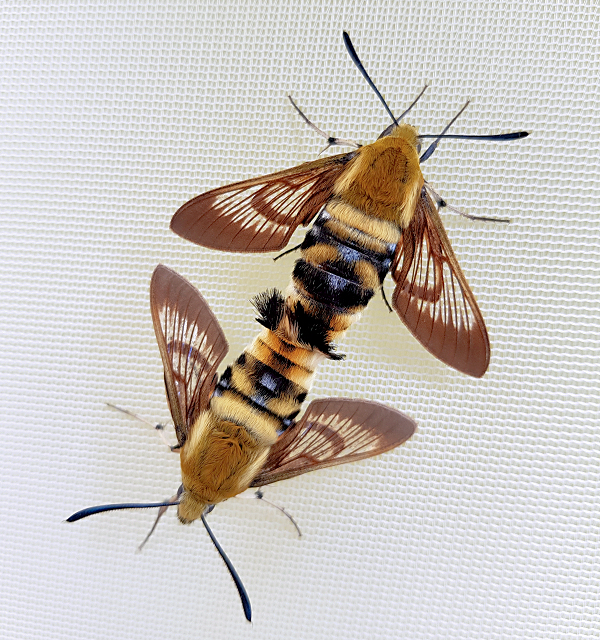
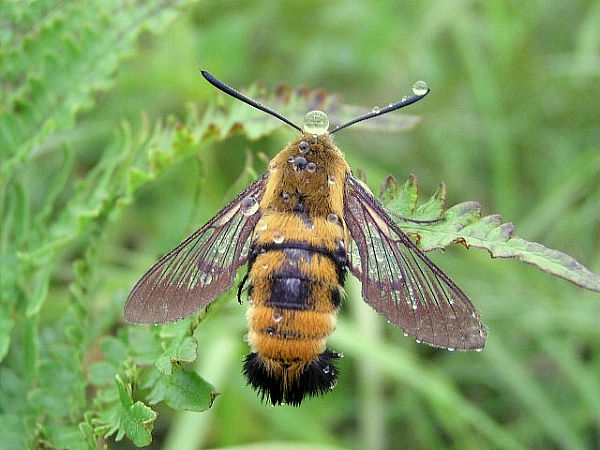
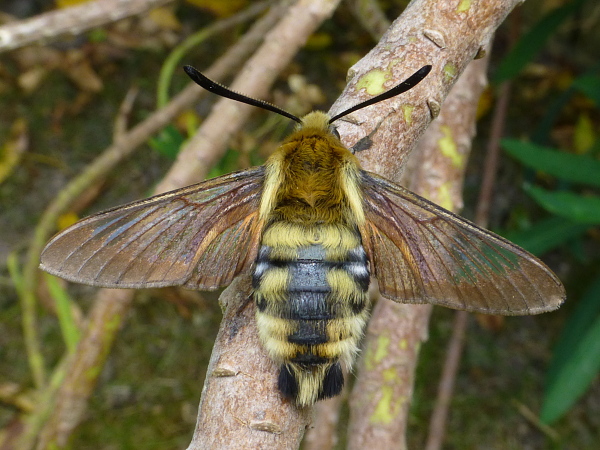
A species of rich meadows in both coniferous and mixed woodlands. Ecologically, this species appears to replace Hemaris tityus over much of Siberia and the Russian Far East (Serge Yevdoshenko, pers. comm. 2018). Attracted to the flowers of Syringa, especially Syringa oblata Lindl. around Beijing.
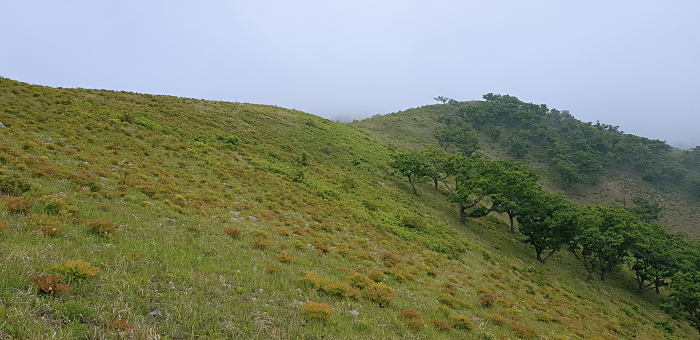
China: iv (Beijing; Zhejiang); v (Gansu); vi (Zhejiang; Beijing); vii (Chongqing; Jiangxi; Heilongjiang; Nei Mongol); viii-ix (Zhejiang). North Korea: vii (North Hamgyong Province). Japan: iv-v (Honshu); 28.vi (Shikoku); vi-viii (Hokkaido; Ryukyu Archipelago); vii (Kyushu); vii-viii (Honshu); 11.viii (Shikoku); ix (Kyushu). Russia: 8.v-11.vi (Primorskiy Krai); 10.vi (Buryatia); 6.vii (Tuva ASSR); 17.vii (Primorskiy Krai); 10.viii (Primorskiy Krai).
Park et al. (1999) give mid May until late July as the flight period in Korea.
OVUM: Ovum small (1.1 x 1.0 mm), almost spherical, with a small dent on the surface; pale glossy green. Laid singly on the underside of the host plantís leaf (Koshkin & Yevdoshenko, 2019).
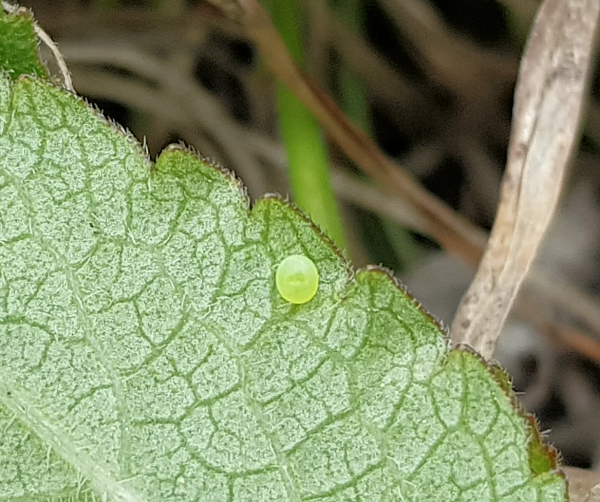
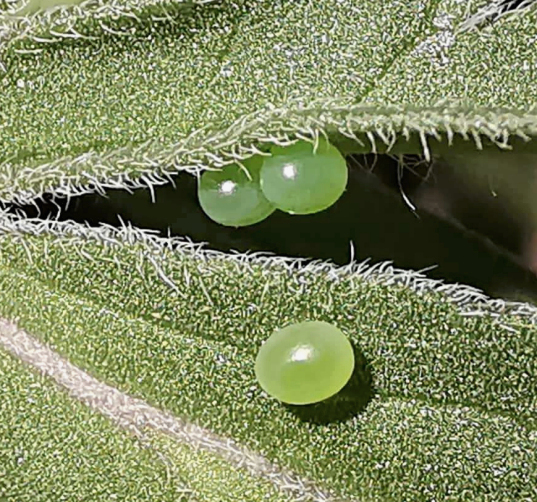
LARVA: Full-fed 47--50 mm. The appearance and ecology of the larva is almost identical to that of the similar western Palaearctic species Hemaris tityus. During its life, the larva generally remains beneath a leaf, nibbling holes on either side of the midrib on which it rests. Mostly active at night, if disturbed during the day it drops to the ground. The growth rate is very fast, with development taking only about two weeks from ova hatching until pupation. The first instar larva is almost indistinguishable from that of H. tityus. Newly hatched larva are about 3 mm long, greyish-white and covered with small black tubercles bearing forked, black hairs. Caudal horn small, black, and forked at the top. In the second instar it becomes greenish-white with just noticeable whitish dorsolateral lines along the body. Spiracles and caudal horn black. The third instar larva is green, with the body covered with numerous tubercles bearing short whitish setae so that it resembles the host plant leaf surface. Spiracles still black, caudal horn reddish at the base and black at the tip. By the fourth instar the main coloration is the same as that of the third instar, but with red spiracles. Caudal horn completely pinkish-red. Full-fed fifth instar larva are mainly whitish-green with a purple-red ventral surface and straight horn of the same colour. The body pattern is also purple-red and very variable -- it can be almost absent or strongly developed. Body and head are densely covered with short light setae. The caudal horn is completely pinkish-violet. Before pupation, larvae change colour from green to plum brown, but not so intensively as in H. tityus. Pupation takes place in a light cocoon among grass debris, under rocks or in the upper layer of soil (Koshkin & Yevdoshenko, 2019).
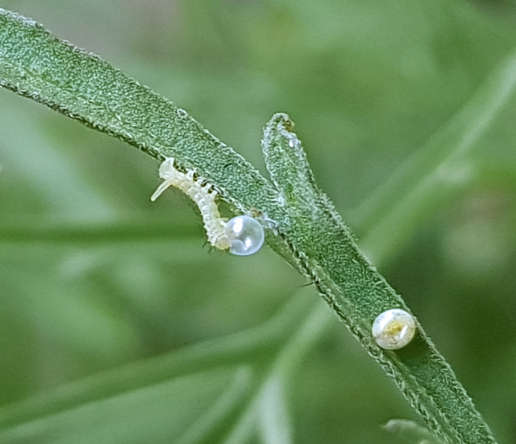
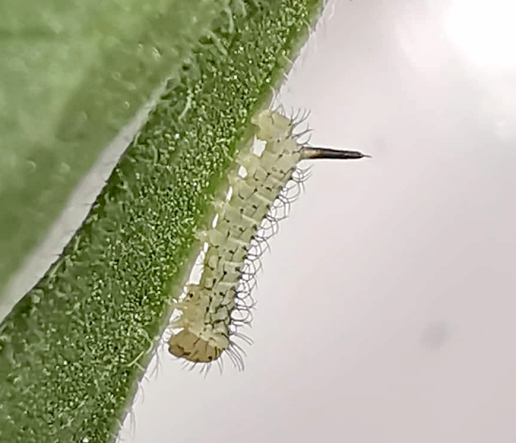
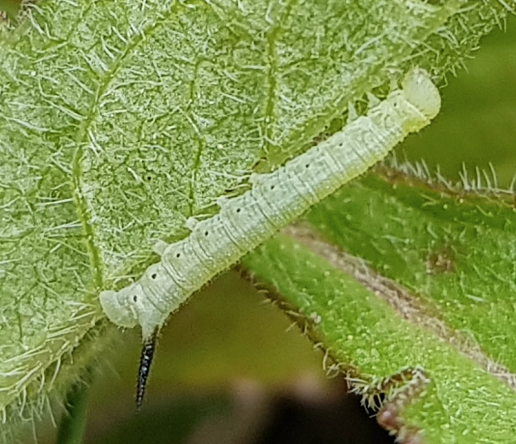
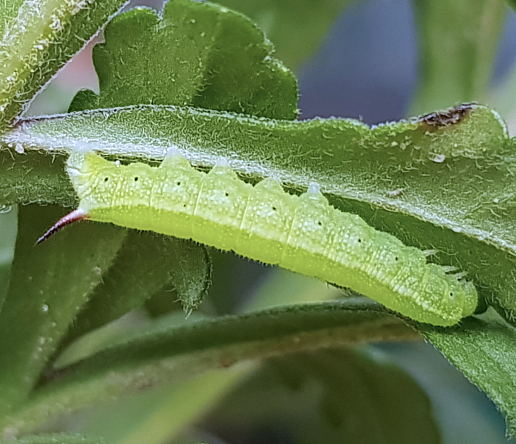
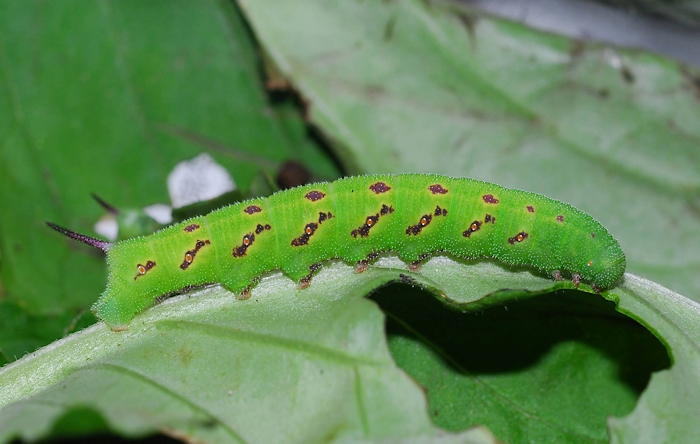
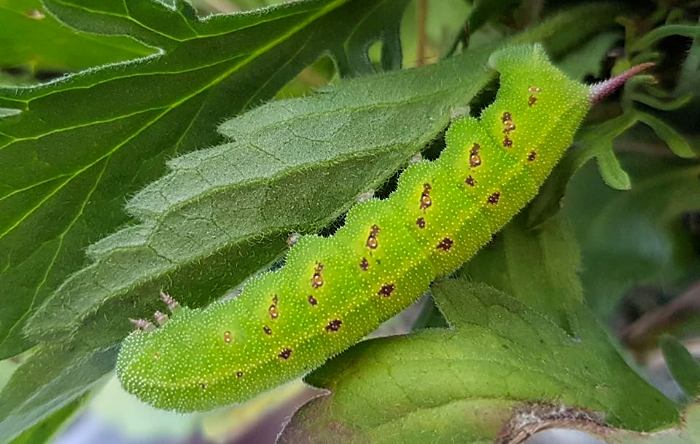
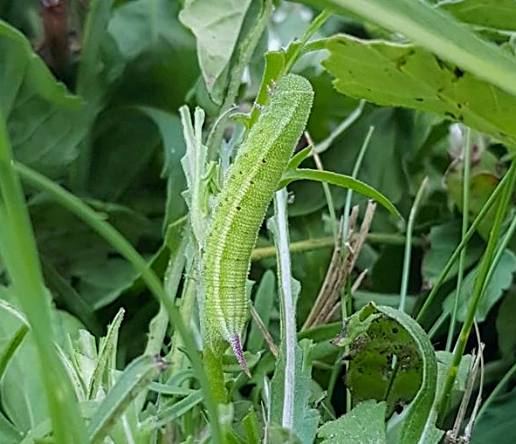
PUPA: 25--28 mm. Oblong, tapered at either end. In colour almost black with blackish-brown intersegmental rings, but glossier than in H. tityus. It is also very similar to H. tityus in shape, but the body is narrower anteriorly, with two prominent sharp head tubercles. The cremaster is flat, triangular. The overwintering stage. Development of first-generation pupae takes from 12 to 14 days (Koshkin & Yevdoshenko, 2019).
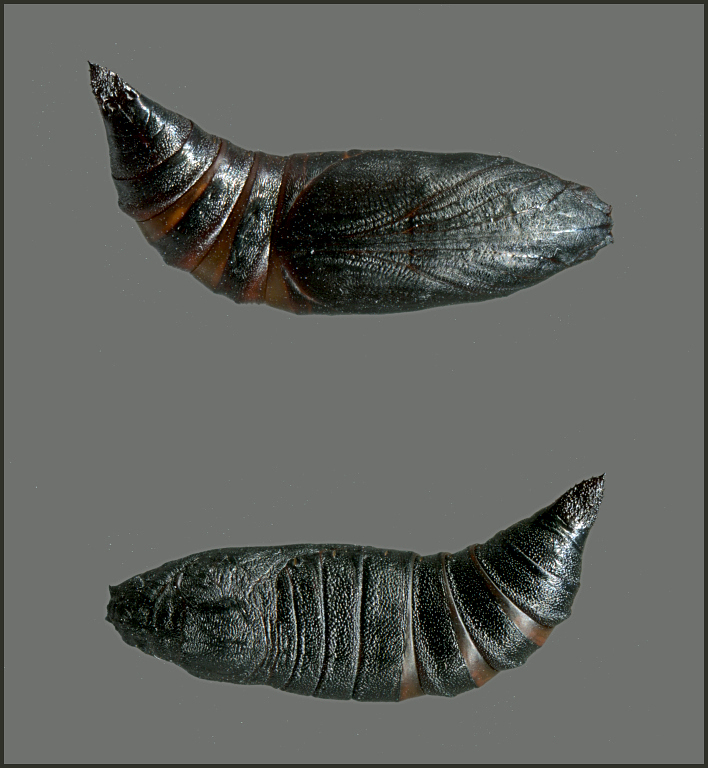
Larval hostplants. Recorded in Primorskiy Krai, Russia, from Lonicera and Rubia (Derzhavets, 1984). In Amurskaya, Russia, recorded from Rubia cordifolia (Streltzov, Osipov & Malikova, 2003). Recorded in Korea on Lonicera japonica (Park et al., 1999). However, Serge Yevdoshenko (pers. comm., 2018) doubts records of Lonicera, having found/reared this species only on Knautia and Scabiosa, notably Scabiosa comosa Fisch. ex Roem. & Schult. [syn. Scabiosa lachnophylla] in Primorskiy Krai, Russian Far East (Koshkin & Yevdoshenko, 2019). Has also been recorded from Patrinia scabiosifolia (formally Valerinaceae, now Caprifoliaceae) in Zhejiang, China (Xu ZhenBang, pers. comm. 2022). Patrinia and Weigela have been recorded from Japan.
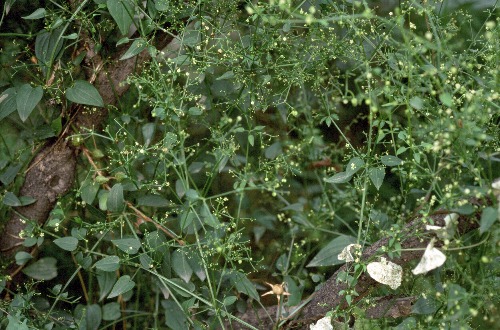
China: Nei Mongol (Da Hinggan Ling, ??Inn Shan, 200m; Jalaid Qi); Heilongjiang (Xiao Hinggan Ling, ??Buchalu, 1100m; ??Barim); Beijing (Mentougou, 1700m; Beijing Botanical Garden; Baihua Mountain National Nature Reserve); Gansu (Maijishan, 1500m); Shanghai; Zhejiang (Tianmu Shan; Mogan Shan; Hangzhou); Chongqing (Jinfo Shan); Jiangxi (Jiujiang).
Mongolia: Sèlèngè Province (Jeröö Gol/River near Duulan-Chan).
North Korea: Kangwon Province (Keumgang-san; Sepo); South Pyongan Province (Pyongyang); North Hamgyong Province (Hoeryong; Ungiryung; Gyungsung; Chongjin).
South Korea: Seoul; Kyonggi Province (Gwangleung; Cheonma-san; Soyo-san; Godae-san; Yongmun-san; Yangpyong; Hwasung); Kangwon Province (Seolak-san; Odae-san; Baeduk-san; Ssangyong); North Chungchong Province (Songni-san); North Cholla Province (Jiri-san); South Cholla Province (Baekyang Temple; Wan-do); North Kyongsang Province (Sangju; Jikji Temple; Juwang-san); South Kyongsang Province (Tongdo Temple; Hadong; Hamyang); Cheju Province (Cheju-do).
Japan: Hokkaido (Hakodate; Ishikawa; Mt Iwamuro; Sapporo); Honshu (Fushiki; Kuroson Tosa; Mukoyama; Oiwake; Tokei-ji; Nagasaki; Tokyo; Nikko; Yoshino; Yokohama; Nagano; Oki Islands); Shikoku (Kochi City); Kyushu (Kagoshima; Unzen); Tsushima; Ryukyu Archipelago (Okinawa; Ishigaki-jima; Iriomote-jima).
Russia: Tuva ASSR (Naryn River, 1500m); Buryatia (Ulan-Ude (Daba, iNaturalist 2023)); Transbaikalia (Butyvken; Nizhnii Tsasuchei); Amurskaya (Blagoveshchensk); Khabarovskiy Krai (Pivan); Primorskiy Krai (18km SE Ussuriysk; Primorskiy; Khasan; Andreevka; Gayvoron; Narva; Pogranichniy).
The Tuvinian individual, captured on 6.vii.1996 at 50°08'N 96°00'E (Danner, Eitschberger & Surholt, 1998), may indicate that this species is spreading westwards in response to global warming.
Southern Siberia, Mongolia, the southern Russian Far East, northeastern and central-eastern China, the Korean Peninsula and Japan.
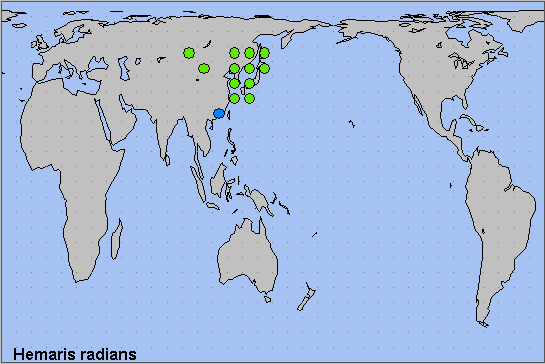
Holarctic; eastern Palaearctic region. Pleistocene refuge: Polycentric -- Japanese and Sinopacific refugia.
 Return to Sphingidae of the Eastern Palaearctic species list
Return to Sphingidae of the Eastern Palaearctic species list